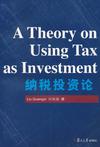纳税投资论
出版时间:2004-4 出版社:复旦大学 作者:刘光溪 页数:452
内容概要
本书基于已有的关于“政府与公众”关系和税收理论与管理的早期研究成果,提出了“纳税是纳税人向政府的一种投资”即“纳税投资”的主题观点,然后利用投资的一般规律和制度经济学的最新成果,比较系统地论述了纳税投资的理论内涵及实践应用,前瞻性地提出了基于纳税投资理论如何构建新型的政府与公众关系的路径依赖,以确保作为公众向政府投资的税收不被滥用、挪用和无效率地使用,并为纳税人提供有较高纳税投资回报的升值公共服务,逐步从根本上改变长期以来对税收概念所形成的什么强制性、无偿性的既有观念,以便从思想启蒙的角度推动体制改革与制度创新等政治文明建设,改革和完善税收体制。本书提出的主题观点应该说在现代制度经济学的前沿研究领域有所创新和突破。
本书为全英文版。
作者简介
刘光溪,1965年1月出生,山东五莲人,教授、博士生导师。首届十大杰出外事青年,2001年以“最具责任感”而入选中国“十大新锐青年”。现任职于国家外汇管理局。1981年至1988年就读于山东师范大学外语系和对外经济贸易大学,先后获英美文学学士和工商管理硕士学位。1994年至1996年,赴中国驻日内瓦联合国代表团工作,并在职攻读“WTO与区域经济”研究方向的经济学博士。1991年至1997年历任中国驻美使馆三秘、中国驻日内瓦联合国代表团二秘和外经贸部国际司WTO处和长。1997年始任外经贸部首席谈判代表的特别助理。2000年被任命为中国驻洛杉矶总领馆商务参赞。作为中国代表团主要成员参与了13年中国复关/入世的实质性谈判工作。相继提出了“互补性竞争——区域集团与WTO关系的核心”、“应对入世——观念入世最重要”、“区域产业非协调发展”、“入世标志着改革促开放转向开放促改革”、“制度创新是第一竞争力”等诸多颇有影响的理论与学术观点。专著有《互补性竞争论:区域集团与多边贸易体制》、《中国与“经济联合国”:从复关到入世》、《磁撞融合发展——亲历13年复关入世谈判的思索》《入世与中国经济》和《经济全球化·世贸组织·中国》。发表论文157篇。其中《互补性竞争论》获得1996年度中国国际贸易最高学术奖——“安子介国际贸易研究优秀著作一等奖”。
书籍目录
Introduction
Chapter One
The Ideological Origin of the Theory of Tax Investment
Chapter Two
The Proposition of the Theory of Tax Investment
Chapter Three,
Basic Ideas of the Theory of Tax Investment
Chapter Four
Tax Investment and Storing Wealth in People's Hands
Chapter Five
Tax Investment and Limited Government
Chapter Six
Tax Investment and Government with High Efficiency
Chapter Seven
Tax Investment and Establishment of Clean Government
Chapter Eight
Tax Income Investment and Traparent Government
Chapter Nine
Tax Investment and People-Centric Government
Chapter Ten
Tax Investment and the Rule of Law
Chapter Eleven
Tax Investment and Ethic Government
Chapter Twelve
Tax Investment and Public Supervision
Chapter Thirteen
Tax Investment Theory and Establishment of a Legal State
Chapter Fourteen
Compariso of Tax Investment and Tax System
Chapter Fifteen
Tax Investment and Tax Reform
Postscript
章节摘录
With the rapid development and wide application of technology and the establishment of mass production, complete Laissez Faire cannot solve many problems due to flaws in the market itself. In the market system, social resources are allocated by the function of price as a mechanism. However, there must be preconditions in order for this mechanism to work, not to mention that the market is not versatile. There is al- ways a possibility of dysfunction or malfunction of the market. The malfunction of the market is shown in the following eight respects: (1) The market mechanism cannot solve the problem of the balance of macro? Totality. The malfunction of the market causes the imbalance of macro-totality, and the market mechanism cannot control inflation. The market has to rely on government macro-financial policy and monetary policy to help solve this problem. This is exactly what the major capitalist nations normally do in practice. (2) The market mechanism cannot solve the problem of long-term development of the national economy because it cannot predict economical change in the future; neither can it grasp the complicated structure of demand and supply. Its regulatory function works only for short-term. It needs the making and execution of economic plan by the government to help solve this problem. (3) The market mechanism can hardly regulate and optimize the industrial structure due to the difficulty in the flow of capital and labor, the damage on the market mechanism afflicted by market monopoly, and the high price to pay for the market regulation in contemporary market conditions. The government is required to make and execute industrial policies to regulate the industrial structure.
图书封面
评论、评分、阅读与下载
用户评论 (总计0条)
相关图书
- 山西省公路里程地图册
- 中国瓦当艺术
- 彩图解说果树害虫的识别与防治
- 中国顶级保护动物.大熊猫
- 小学语文配套写字教材(1年级配合全日制义教新课程标准)
- 心理健康千金方
- 教你认字写字
- 高考聚焦百问百题:文科综合(政治历史地理) (平装)
- 癫痫病人家庭护理
- 新型数码手机故障检修实例
- 《应用写作教程》教与学参考书
- 绿色学习:7年级英语(第1学期)(新课标)(教材名师解读)(配人教版课标教材) (平装)
- 红灼墨染
- 实用透析手册
- 小学快车道双标准测试卷:语文8 (平装)
- 肺癌
- 江苏旅游文化
- 网上聊天幽默妙语
- 经学研究论文选
- 文言知识小锦囊
- 中国古代服饰风俗
- 诺贝尔文学奖获奖作家代表作管窥
- 世界奇趣集粹
- 走向经典
- 京韵杂述
